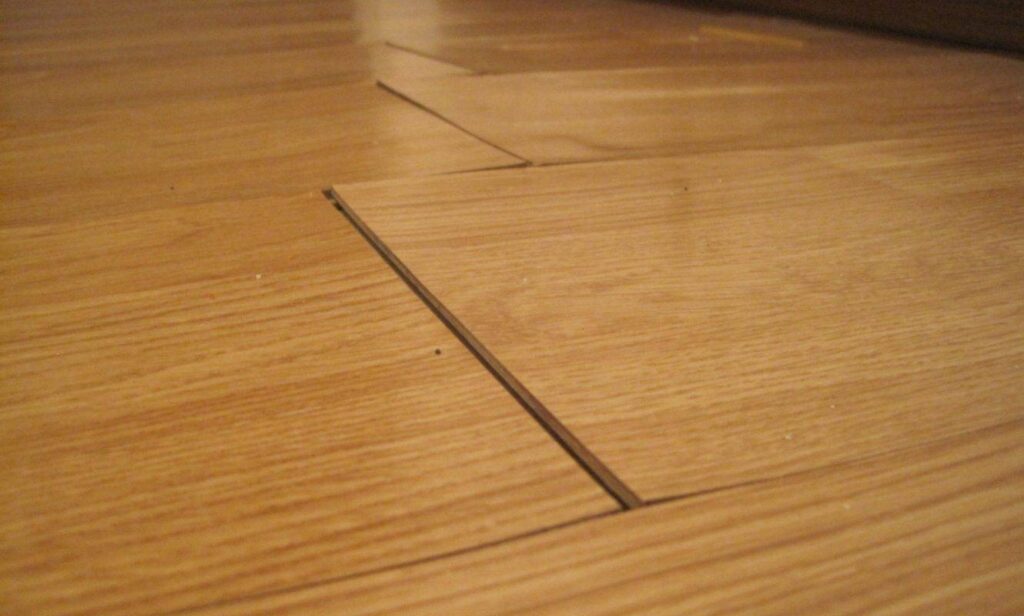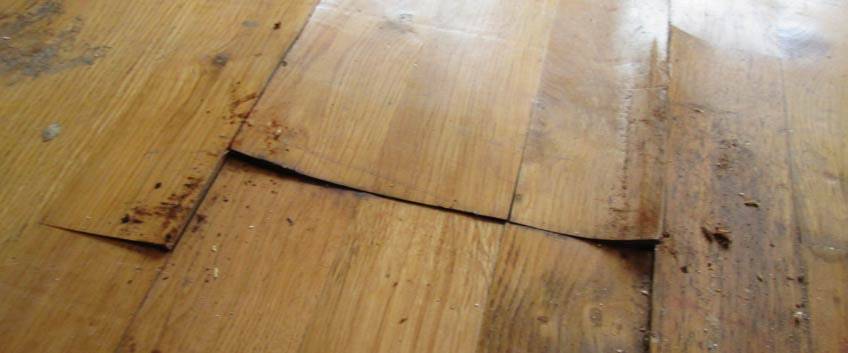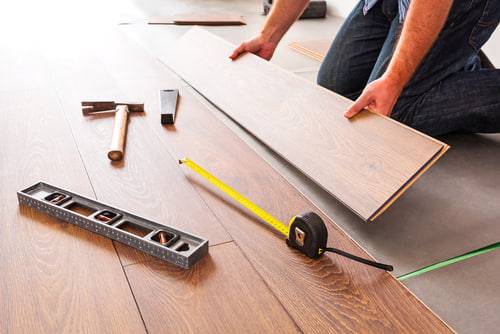While solid hardwood floors are beautiful, they can be prone to developing gaps between the planks, especially after water damage. These gaps can become so large that the entire floor needs to be replaced.
Engineered hardwood flooring offers a more stable alternative. It’s designed to resist warping and gapping caused by changes in humidity, which is a major advantage over solid hardwood.
However, even engineered hardwood floors can develop gaps occasionally. This can be due to several factors, such as:
- Fluctuations in humidity: Maintaining consistent humidity levels in your home is crucial for preventing gaps in any type of hardwood flooring.
- Improper installation: Uneven subfloors or incorrect spacing during installation can contribute to gapping.
- Material flaws: In rare cases, there may be imperfections in the engineered wood itself that lead to gaps.
It’s important to remember that some gapping is normal, especially during seasonal humidity changes. However, if the gaps are excessive or persistent, it’s best to consult a professional flooring installer to diagnose the cause and recommend a solution.
Humidity: One of the Key Factors Causing Gaps in Engineered Wood Flooring
Engineered wood flooring is a popular choice for homeowners due to its beauty, durability, and stability. However, even engineered wood can be susceptible to gapping, which can detract from its appearance and functionality. One of the key factors that can cause gapping in engineered wood flooring is humidity.
How Humidity Affects Engineered Wood Flooring
Engineered wood, like all wood products, is hygroscopic, meaning it absorbs and releases moisture from the air. When the humidity level in the air is high, the wood absorbs moisture and expands. Conversely, when the humidity level is low, the wood releases moisture and contracts.
The grain of the wood also plays a role in how it reacts to humidity changes. Wood moves most across the grain, rather than with the grain. Traditional hardwood flooring boards (and the top layer of engineered floors) are cut parallel to the grain.
As a result, the boards tend to get wider and narrower (across the grain) more than they get longer and shorter (with the grain). This means that changes in humidity can cause the boards to cup or warp, which can lead to gaps between the planks.
Preventing Gapping in Engineered Wood Flooring
The best way to prevent gapping in engineered wood flooring is to maintain a consistent humidity level in your home. The ideal humidity range for engineered wood flooring is between 30% and 50%. You can use a hygrometer to measure the humidity level in your home and a humidifier or dehumidifier to adjust it as needed.
In addition to maintaining a consistent humidity level, you can also help to prevent gapping by:
- Acclimating the wood flooring before installation. This involves storing the wood flooring in the room where it will be installed for several days so that it can adjust to the humidity level.
- Leaving an expansion gap around the perimeter of the room. This gap will allow the wood flooring to expand and contract without putting stress on the planks.
- Using a vapor barrier under the wood flooring. This will help to prevent moisture from the subfloor from reaching the wood flooring.
Installation: Another Culprit Behind Gapping in Engineered Wood Flooring
While humidity reigns supreme as a cause of gaps in engineered wood floors, improper installation plays a silent, yet equally important, role. Let’s delve deeper into how installation missteps can lead to unsightly spaces between your beautiful wood planks.
Common Installation Pitfalls:
- Expansion Space Mishap: Imagine flooring suffocating! Failing to leave adequate expansion space around the perimeter traps the wood, leaving no room for natural expansion and contraction during humidity fluctuations. This results in unsightly gaps later.
- Acclimation Anxiety: Just like humans need to adjust to new environments, so does engineered wood. Skipping the crucial acclimation step, where the wood adapts to the room’s specific humidity, sets the stage for dimensional changes and gaps after installation.
- Fastener Faux Pas: Using the wrong adhesives or fasteners might seem harmless, but it’s not. Choosing unsuitable materials for your specific wood and subfloor leads to weak joins, which translates to gaps over time.
Identifying Installation-Related Gaps:
Unlike their humidity-induced counterparts, installation gaps usually appear soon after installation and tend to be concentrated around specific areas, like walls or transitions.
Prevention is Key:
Remember, an ounce of prevention is worth a pound of cure. Choosing a qualified and experienced flooring contractor who meticulously follows proper installation procedures can significantly reduce the risk of gaps.
Material Flaws: The (Less Common) Gap Culprit in Engineered Wood Flooring
While humidity and installation errors reign supreme as gap-causing culprits in engineered wood floors, it’s important to acknowledge a less common offender: material flaws.
Understanding Material Flaws:
Manufacturing defects or improper storage can sometimes lead to warped or cupped planks within the engineered wood itself. These warped planks then struggle to fit together seamlessly, resulting in unwanted gaps. While uncommon, it’s crucial to be aware of this potential cause.
Identifying Material Flaws:
Unlike gaps stemming from humidity or installation, those due to material flaws often manifest differently:
- Gaps appear soon after installation, not gradually over time.
- Gaps might be concentrated in specific areas where warped or cupped planks are present.
- Gaps could be accompanied by visible warping or cupping of individual planks.
Addressing Material Flaws:
If you suspect material flaws are to blame for gaps in your engineered wood flooring, immediate action is essential:
- Contact the manufacturer or retailer right away. They should be able to guide you through warranty options and potential replacements.
- Do not attempt repairs yourself. Improper repairs could further damage the flooring and void warranties.
Conclusion: Enjoy the Beauty and Stability of Engineered Hardwood Flooring with Confidence
While engineered hardwood flooring offers excellent stability compared to its solid counterpart, understanding the potential causes of gaps is crucial for maintaining its beauty and functionality. Remember, humidity, installation, and even rare material flaws can contribute to gaps.
Fortunately, preventative measures exist:
- Maintain consistent humidity levels using a hygrometer and humidifier/dehumidifier.
- Choose a qualified installer who follows proper procedures, including acclimation and expansion gaps.
- Inspect for visible warping or cupping before installation and purchase from reputable sources.
By taking these steps and addressing any issues promptly, you can ensure your engineered hardwood floor remains a stunning and gap-free feature of your home for years to come.
FAQs about Gaps in Engineered Hardwood Flooring:
Q: Are any gaps normal in engineered hardwood flooring?
A: Slight gaps, especially during seasonal humidity changes, are considered normal. However, excessive or persistent gaps require attention.
Q: What’s the ideal humidity level for engineered hardwood flooring?
A: Maintain a consistent humidity level between 30% and 50% using a hygrometer and humidifier/dehumidifier.
Q: How can I prevent gapping caused by installation?
A: Choose a qualified installer who:
- Leaves proper expansion gaps around the perimeter.
- Acclimates the wood flooring to the room’s humidity before installation.
- Uses the correct adhesives and fasteners for your specific wood and subfloor.
Q: Can I fix small gaps myself?
A: For small gaps, consult a professional first. Depending on the cause, they might recommend wood filler or other solutions. Avoid DIY repairs for larger gaps or suspected material flaws.
Q: What if I suspect material flaws causing gaps?
A: Act immediately! Contact the manufacturer or retailer for warranty options and potential replacements. Avoid DIY repairs to prevent further damage and voiding warranties.
Q: Does engineered hardwood flooring with a warranty guarantee no gaps?
A: Warranties typically cover specific manufacturing defects, not gaps caused by other factors like humidity or installation.
Q: Are there specific types of engineered hardwood flooring less prone to gaps?
A: Consult a flooring professional for recommendations based on your specific needs and climate. They can advise on plank width, construction methods, and brands known for superior stability.
Q: Where can I learn more about caring for engineered hardwood flooring?
A: Consult the manufacturer’s instructions, flooring industry websites, or professional installers for detailed care and maintenance guidance.



